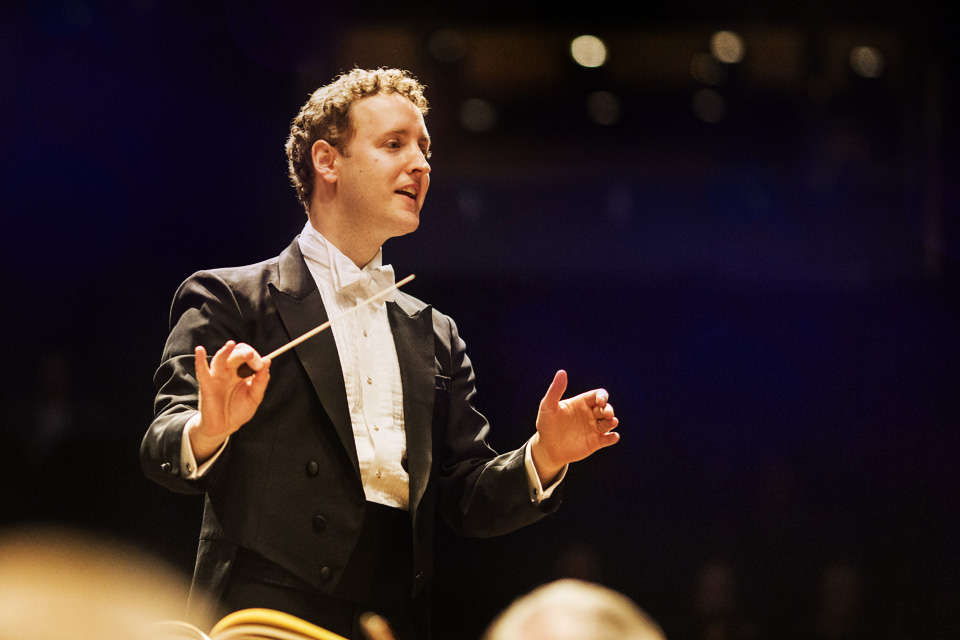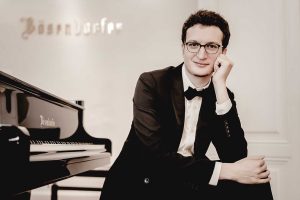Guest Conductor Michael Francis Brings His Panache to the San Diego Symphony
After experiencing Rafael Payare’s blockbuster program of Shostakovich and Britten last Friday, Sunday’s visit to Disney Concert Hall to hear John Adams conduct the Los Angeles Philharmonic in his “Grand Pianola Music” as well as a new symphony by Phillip Glass, and then more Adams and Matthew Aucoin on Tuesday’s “Hearing the Future” chamber music program in La Jolla, I felt a sense of backsliding attending Michael Francis’s program of familiar standard repertory from the early 19th century Friday (January 18) at the San Diego Symphony.

Michael Francis [photo courtesy of Mainly Mozart Festival]
But if Michael Francis could not turn back the clock from the stage of Copley Symphony Hall, he did successfully refreshed Berlioz’ Symphonie fantastique for his listeners’ ears. Maintaining sparkling, transparent textures, choosing exquisitely calibrated tempos, and keeping the drama alive without ever overplaying his hand brought these familiar musical episodes into sharp, arresting focus. It was like viewing for the first time a very old oil painting that curators have painstakingly restored to its original vivid hues.
Although Francis has not previously conducted this orchestra, he is well-known to the San Diego music scene. A few seasons back he succeeded David Atherton as Music Director of the Mainly Mozart Festival Orchestra, which performs every June at the Balboa Theatre. Francis appeared to relish conducting the large symphonic forces needed for the Berlioz: the number of players in all the wind sections for this symphony equaled the typical size of his Mainly Mozart chamber orchestra on the Balboa stage.
Francis opened his concert with Felix Mendelssohn’s frequently programmed tone poem “The Hebridies,” a pictorial masterpiece of the windswept waters off the Scottish coast from the young composer, also known as “Fingal’s Cave.” The orchestra gave a polished but aptly muscular account of the work, although I found Francis’ busy, sometimes heroic gesturing on the podium distracting—more activity than the cleverly orchestrated and constructed piece required. And I feared a parallel amount of podium calisthenics for the lengthy Berlioz symphony would a major distraction.
Fortunately, Francis settled into the task of shaping the Berlioz with deft attention to detail and a calm assurance that focused its many moods and cannily calibrated its amazing psychological and musical journey. Keeping the audience engaged in the brassy, snarling “March to the Scaffold” movement is easy, but Francis proved his mettle in “The Scene in the Fields,” the long, slow middle movement with its gentle rustic themes threatened by distant thunder. The duet of traditional shepherds’ piping that opens the movement, intoned with mournful yet tender phrasing by Andrea Overturf’s haunting English Horn and the gentle, muted offstage echoes of Principal Oboe Sarah Skuster framed this glowing movement, while the ominous, dark rolling of the Principal Timpanist Ryan J. Dilisi and his assistant Andrew Watkins crept in as the movement approached its final cadence.
Berlioz the wizard of orchestration pulls out all the stops in his finale, “Witches Sabbath,” and Francis wisely saved the orchestra’s power and technical brilliance for this heady movement. I particularly appreciated that the deep brass invocations of the dreaded “Dies irae” chant sounded aptly threatening, but they did not descend to an unseemly blare.

Rodolfo Leone [photo (c.) Andrej Grilc]
For his encore Leone played Rachmaninoff’s Prelude in G Major, Op. 32, No. 5.
This concert was presented by the San Diego Symphony on Friday, January 18, 2019, at the Jacobs Music Center in downtown San Diego. This program will be repeated Sunday, January 20, in the same venue. On Saturday, January 19, the Berlioz work will be repeated in the context of a special program titled “Beyond the Score: Symphonie Fantastique,” with tenor Bernardo Bermudez, actor Matthew Krause, and dancer Zoe Irvine. Michael Francis will conduct the orchestra.

Ken Herman, a classically trained pianist and organist, has covered music for the San Diego Union, the Los Angeles Times’ San Diego Edition, and for sandiego.com. He has won numerous awards, including first place for Live Performance and Opera Reviews in the 2017, the 2018, and the 2019 Excellence in Journalism Awards competition held by the San Diego Press Club. A Chicago native, he came to San Diego to pursue a graduate degree and stayed.Read more…


